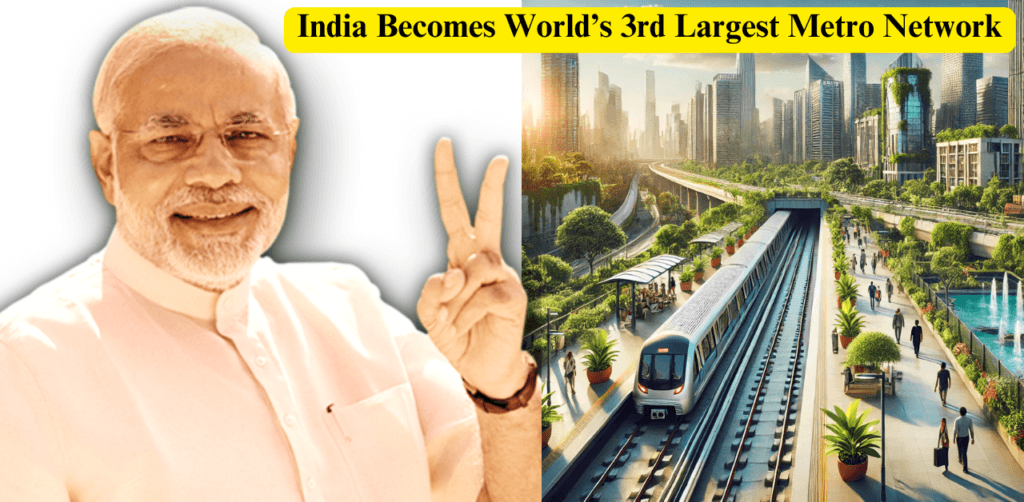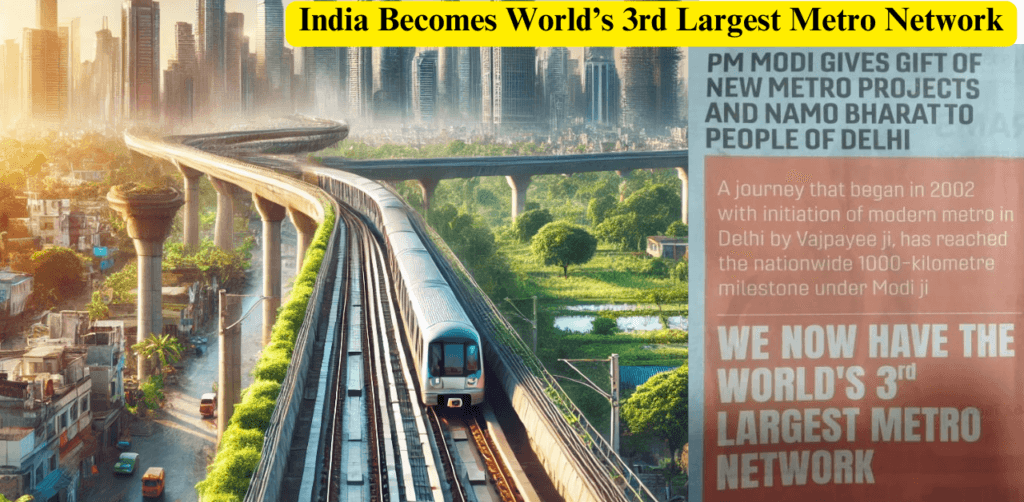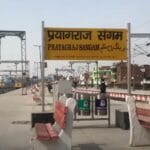
Table of Contents
India Achieves World’s 3rd Largest Metro Network: A Landmark Achievement Under PM Modi
India Becomes World’s 3rd Largest Metro Network
India Becomes World’s 3rd Largest Metro Network : India has taken a giant leap in urban mobility by becoming home to the world’s third-largest metro rail network. Under the visionary leadership of Prime Minister Narendra Modi, the country’s metro network has crossed the remarkable milestone of 1,000 kilometers, revolutionizing urban transportation and reshaping the way millions of Indians commute daily.

From 248 km to 1,000 km: A Transformative Journey
The journey of metro development in India began in 2002 with the launch of Delhi Metro under the leadership of former Prime Minister Atal Bihari Vajpayee. Fast forward to 2024, the network has expanded threefold under PM Modi’s government—from 248 kilometers in 2014 to a staggering 1,000 kilometers today. This incredible growth reflects the government’s commitment to modernizing urban infrastructure and ensuring sustainable development.
Such an expansion has brought the benefits of world-class public transportation to millions of people across urban India, reducing travel times, enhancing convenience, and promoting environmentally friendly travel.
Metro Expansion Across 11 States and 23 Cities
One of the most notable achievements of India’s metro expansion is its wide reach. In 2014, metro services were operational in just 5 states and 5 cities. Today, the network extends to 11 states and 23 cities, including key urban centers such as Delhi, Mumbai, Bengaluru, Kolkata, Hyderabad, Chennai, Kochi, Jaipur, Lucknow, and Nagpur.
This expansion has ensured that metro services are no longer confined to a handful of major cities but are now accessible to people in Tier 2 cities, significantly boosting connectivity and economic growth.
Over 1 Crore Passengers Served Daily
India’s metro systems are now a lifeline for more than 1 crore daily commuters, representing a remarkable 2.5x increase from 28 lakh passengers in 2014. This surge underscores the growing trust in metro services as the preferred mode of urban transportation.
By offering a fast, reliable, and affordable commuting option, metro rail systems have not only reduced the dependency on private vehicles but have also eased the burden on overcrowded city roads.
Sustainability in Action: Covering 2.75 Lakh Kilometers Daily
India’s metro trains collectively cover a daily distance of 2.75 lakh kilometers, a threefold increase from the 86,000 kilometers they covered in 2014. This expansion has had a transformative impact on urban mobility by:
- Reducing Traffic Congestion: Metro systems have significantly decongested city roads, saving millions of hours in travel time annually.
- Cutting Down Pollution: By offering an eco-friendly alternative to fuel-driven private vehicles, metros have contributed to reducing air pollution in urban areas.
- Promoting Sustainability: Modern metro systems are energy-efficient, and many are increasingly adopting renewable energy sources, further supporting India’s environmental goals.
Key Features of India’s Metro Revolution
- Technological Advancements: Indian metros boast state-of-the-art technology, including automated ticketing, real-time train tracking, and high-speed connectivity.
- Accessibility and Inclusivity: The metro network has been designed to accommodate differently-abled passengers, with features like ramps, elevators, and dedicated spaces in trains.
- Boost to Employment: The expansion of metro services has generated thousands of direct and indirect jobs, boosting the local economy and infrastructure sectors.
The Visionary Leadership Behind the Success
PM Modi has consistently emphasized the importance of modern infrastructure as a driver of economic growth and urban development. Initiatives like “Make in India” and “Atmanirbhar Bharat” have played a pivotal role in accelerating the indigenization of metro technology, reducing costs, and creating a robust domestic ecosystem for metro projects.
The launch of the NaMo Bharat Metro further highlights PM Modi’s dedication to bringing transformative changes to urban transportation. By prioritizing metro expansion, the government has demonstrated its commitment to improving the lives of citizens and ensuring sustainable urban development.
Global Recognition: India as a Metro Leader
With 1,000 kilometers of operational metro lines, India has now overtaken many developed countries in terms of metro connectivity, securing its position as the world’s third-largest metro network, after China and the United States. This milestone places India among global leaders in urban transportation and showcases its capability to execute large-scale infrastructure projects.
Challenges Overcome
The journey to achieving this milestone was not without its challenges. From land acquisition issues to funding constraints, the government tackled various hurdles head-on. By adopting innovative financing models like Public-Private Partnerships (PPP) and engaging with international agencies for technical expertise, these challenges were successfully addressed.
What’s Next for India’s Metro Revolution?
The government has set ambitious goals for the future of metro connectivity. Upcoming projects aim to expand the network further to Tier 3 cities, ensuring that the benefits of modern public transportation reach even more Indians. Additionally, metro systems are increasingly incorporating green technologies, such as solar power and energy-efficient trains, to achieve net-zero emissions.
The Impact on Urban Life
The metro revolution has not just changed how Indians commute but has also improved the quality of urban life by:
- Enhancing connectivity between residential, commercial, and industrial areas.
- Reducing commuting costs and time.
- Encouraging economic development around metro corridors.
- Offering a safe and secure mode of transport, especially for women and senior citizens.
FAQs About India’s Metro Expansion
1. How has the metro network grown under PM Modi’s leadership?
The metro network has grown from 248 km in 2014 to over 1,000 km, a threefold increase in just a decade.
2. Which cities currently have metro services?
Metro services are operational in 23 cities, including Delhi, Mumbai, Bengaluru, Hyderabad, Chennai, and Kochi.
3. What are the environmental benefits of the metro system?
Metro systems reduce pollution by decreasing the use of private vehicles and promoting sustainable transportation.
4. How many people use metro services daily?
Over 1 crore passengers use metro services daily, up from 28 lakh in 2014.
Conclusion
India’s achievement of becoming the world’s third-largest metro network is a testament to its determination, innovation, and leadership. Under PM Modi’s guidance, metro rail systems have transformed urban mobility, offering a sustainable and efficient solution for millions of Indians.
As India continues to expand its metro footprint, the future looks promising for a greener, smarter, and more connected urban India.


